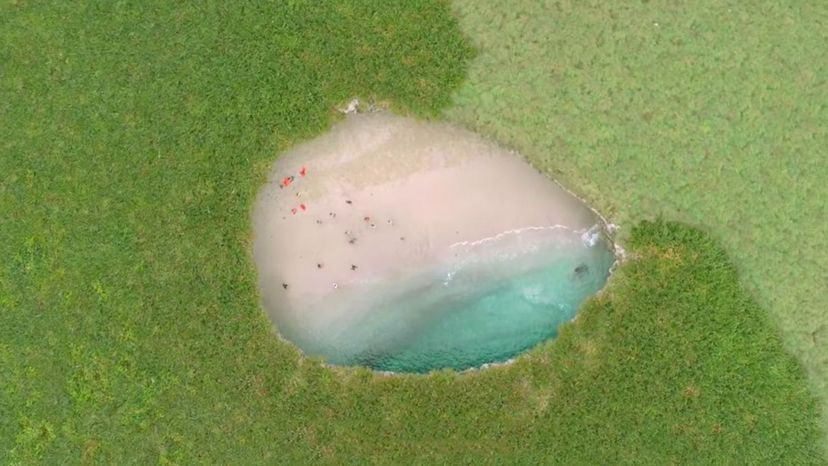
About This Quiz
Mexico is America's neighbor to the south, but how well do you know this large and diverse country? Test your Mexico knowledge with this HowStuffWorks quiz!A landlocked country is one with no coastline or direct access to the sea. Mexico is flanked by both the Pacific Ocean and the Gulf of Mexico.
Mexico and the U.S. share a border, several of their states touching. For example, the states of Coahuila and Texas share a border.
There are a number of deserts in North America. These include the Chihuahuan Desert, Coahuila Desert, and the Deserts of Nueva Leon.
Advertisement
The Caribbean Sea is one of the biggest seas, with over 1,000,000 sq mi to its name. It also has the world's second-biggest barrier reef, The Mesoamerican Barrier Reef.
Mexico is divided into 31 states. Its official name is the United Mexican States.
Mexico has 31 states. This does not include Mexico City, which is a federal entity but not a state on its own.
Advertisement
This 100,000-square mile desert straddles the American-Mexican border. It often reaches 120 degrees there during the day.
Mexico has a number of mountain ranges. These include high volcanic peaks and Pico de Orizaba, which is one of the highest mountains in North America.
Central America is south of Mexico. The countries Guatemala and Belize border it.
Advertisement
North America is comprised mostly of Canada, America, and Mexico. It is the third largest continent.
Mexico sits on top of three large tectonic plates, making it one of the most active seismological regions in the world. 90% of the world's earthquakes occur in the Pacific Ring of Fire, which Mexico is a part of.
Mexico has roughly 150 rivers, however, they are not evenly distributed throughout the country. Only one major river flows outside Southeast Mexico.
Advertisement
The Pacific Ocean bounds Mexico to the west and south. Mexico has over 5,000 miles of coastline.
The Chihuahuan Desert is the largest desert in North America. At roughly 200,000 square miles, it stretches through Mexico into New Mexico and Texas.
The Gulf of Mexico is an Atlantic ocean basin that touches Mexico. It also touches the U.S. and Cuba.
Advertisement
Mexico is the world's 13th largest country. It is 3 times the size of Texas.
Mexicos's territory includes numerous islands in the Gulf of Mexico, Caribbean Sea, Pacific Coast, Gulf of California and more. It even has some more faraway Islands like Isla Guadalupe in the Pacific.
Mexico narrows considerably as it stretches away from the U.S. and toward Central America. Its southern portion curves distinctively.
Advertisement
This chain of mountain ranges runs through North, South, and Central America to Antarctica. They also form the backbone of the eastern half of the volcanic Pacific Ring of Fire.
Mexico's rivers are not good for navigation and have mostly been important to Mexico in terms of irrigation and hydroelectric power. The Lerma-Santiago river system is the longest river entirely within Mexico's borders.
Mexico has a long history of volcanic eruptions. Two volcanoes which occasionally send out puffs of smoke are visible from the country's capital, Mexico City.
Advertisement
The Tropic of Cancer divides Mexico into two main climate areas. The northern part has a temperate climate and the south has a tropical climate.
Hurricane Alley is an area of water in the Atlantic Ocean that stretches from the coast of North Africa to the east coast of Central and Southern North America. In this area, the sea temperature and other conditions are perfect for the formation of hurricanes from July until mid-fall.
Mexico's two major deserts are the Sonoran and Chihuahuan, which cover larger portions of the U.S.-Mexico border. The Chihuahuan desert is the largest desert in all of North America and the Sonoran is the hottest in Mexico.
Advertisement
Mexico has thousands of miles of coastline on both sides. The Pacific Ocean borders the western shore and The Gulf of Mexico borders the Eastern Shore.
Southern Mexico has jungles, marshes and large mangrove forests. One large rainforest is the Lacandon Jungle, which stretches from the Mexican state of Chiapas through Guatemala and into the Yucatan Peninsula.
Southern Mexico's Lacandon Jungle is the largest montane rainforest in North America, even though most of it has been destroyed. It is the last rainforest in North America big enough to support jaguars and contains over 1,000 tree species and 25% of all of Mexico's animal species.
Advertisement
The Gulf of California, also known as the Sea of Cortez, is a small sea between the Baja California peninsula and mainland Mexico. It is one of the most diverse seas on the planet.
A large portion of Mexico is covered by diverse types of forests. These include tropical forests, evergreen forests, cloud forests and more.
An isthmus is a narrow strip of land that connects two larger areas across water which would separate them without it. The Mexican states of Tabasco and Chiapas are east of the isthmus and Veracruz and Oaxaca are west of it.
Advertisement
The Rio Grande is known as The Rio Bravo in Mexico. It forms an over 1,200-mile long natural border between the U.S. and Mexico.
Pico de Orizaba is the highest mountain in Mexico and third highest in North America. It is a dormant volcano that stands 18,491 feet above sea level between the Mexican States of Veracruz and Puebla.
This largely uninhabited desert is unique in its high number of bodies of water. It's a tourist hotspot full of lakes, rivers and lagoons.
Advertisement
Only 1% of all global woodland is cloud forests, and they can be found in small parts of over a dozen Mexican states. Cloud forests are generally wet types of forest that have constant, frequent or seasonal cloud cover in their canopies.